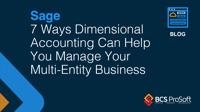Executive Summary:
Sage 100c has been renamed to Sage 100cloud. This is a marketing change only and there is no change to your existing Sage 100 system. It’s still an on-premise solution and you are not being forced to migrate to the cloud. We don’t see it as a bad thing and the change was made to highlight the product’s “connected cloud” capabilities. This will primarily only affect new Sage 100 customers going forward.
Read on for more details or give your account manager a call at (800) 882-6705 for more information.
Sage 100c has been renamed to Sage 100cloud
Earlier this week, Sage announced to their partners that they were going to be rebranding Sage 100c to Sage 100cloud in 2018. All other products in their portfolio are seeing similar rebranding as Sage’s strategy to become a cloud-first company with introduction of the Sage Business Cloud.
During the call Sage said this is a “strategic marketing play to help make the connection between [Sage 100c] and the Sage Business Cloud”. There are no product changes with this name change and Sage 100cloud is still an on-premise solution where it is hosted on your own servers or in a hybrid cloud environment like Amazon Web Services.
This is a stark difference from Sage’s explanation on the meaning of the “c” when it was released where they said that the “c” didn’t officially stand for anything. Some potential meanings they tossed around were “connected” and “customer for life”. I had a feeling this would eventually morph into “cloud” when I first wrote about Sage 100c in 2015.
What is the Sage Business Cloud?
The Sage Business Cloud was created to simplify how Sage talks about their products with descriptive naming to make it easy for to understand what each product does. In a followup email sent to partners after the call, a Sage’s Executive Vice President of Partnerships, Jennifer Warawa, wrote “The Sage Business Cloud vision is to make it easier for our shared customers to understand our offerings and see the full range of solutions we have available to manage an entire business.”
For example, you can probably guess what Sage Payroll is and does. What about Sage One, Sage Intacct, Sage Live or Sage X3? All Sage native cloud products are changing to more descriptive naming—i.e. Sage Accounting, Sage Financials, and Sage Enterprise Management.
Product’s that fall into the “c-line” of Sage products do not have a clear path to the cloud. This doesn’t mean they are going away or you’ll be forced onto a different product. They just weren’t built from scratch in the cloud like Sage’s other products. As Sage indicated, this is a marketing change only and will not be changed in the product itself, or in other communications such as training, invoices, etc.
So why Sage 100cloud if it isn’t cloud based?
Unlike descriptive naming, which is a full change of the name, the connected cloud “c-line” products will simply update the name for marketing (only) to spell out that “c” stands for connected cloud and be combined with simple positioning and messaging that these are desktop products with connected cloud capabilities. The key is to continue to reinforce that Sage has a path for every customer with Sage Business Cloud. Customers can either get to keep the product they know and love and get some of the features they want like automatic data backups, invoicing in the field, etc. with their connected cloud products.
Sage’s EVP of Partnerships wrote “we are updating the nomenclature within the c-line to further emphasize the cloud benefits of these products.” What this means is that Sage 100cloud is still on-premise, but certain cloud-based features are only available on the c-line. To get all the benefits that these other native cloud add-ons provide, you need to be on a Sage 100cloud subscription.
What’s the difference between Sage 100 and 100cloud?
Sage 100cloud is essentially the same product as the Sage 100 (formerly MAS 90/200) you may be using today, but with an updated user interface and greater access to new and future features. There is no re-training and your solution is still deployed on-premise. It includes several “connected cloud” integrations for add-on products and features that are hosted in the cloud, such as:
- Office 365 integration
- Sage Inventory Advisor
- Enhanced Search, Custom Dashboards
- Multi-Bin and AP Automation
- Sage Intelligence Report Manager and Report Designer Module
- Budget and Planning – “What if Scenarios”
- Automatic backups
The most significant difference is that Sage 100cloud is a subscription, which must be kept current to continue using the software. There is no re-training and your solution is still deployed on-premise.
Will I be forced to move to the Cloud?
No. Remember, the word “cloud” here is a marketing change only. Sage 100 is not a cloud-based ERP system. However, Sage is certainly trying to incentivize migrating from your normal Sage 100 maintenance plan (perpetual pricing) to the subscription-based pricing on “c-line”.
You may have already received a communication from Sage where they are encouraging customers to move to Sage 100c and cap the renewal rate at 10% by introducing what is called “zero-dollar migration”. In turn, Sage is raising the maintenance amounts by 20% for all customers on the perpetual pricing model (those not on 100c) with renewals starting in April 2018—a trend we will likely continue to see until it makes more financial sense to move to the subscription.
What’s BCS ProSoft’s take?
We get it and we don’t think it’s a bad thing. I don’t think Sage is being deceptive in any way. In fact, I’m excited to see what else Sage has in store for the product over the next few years. Sage 100 is a big system and not just something that can be ported into the cloud without creating a new product. While that may happen one day, giving customers the ability to connect Sage 100 to an ecosystem of cloud products is only a good thing.
Sage should have just called it 100cloud instead of 100c to begin with. It probably would have been less confusing. While it may confuse for some existing customers, new Sage 100 users will not know the difference. Part of me thinks that Sage 100cloud may eventually completely cloud-based, but by then people will be so used to the subscription pricing and hearing “cloud” in the name that when it comes time to migrate they’ll be confused because they already thought they were in the cloud.
Some customers will baulk at the idea of going on a subscription-based product, but remember, no one is being forced. Some may even threaten to ditch Sage 100 entirely, which doesn’t make financial sense because the subscription pricing is cheaper than paying maintenance. But I think they’ll be disappointed when they learn that every comparable system is subscription-based these days. Even QuickBooks is subscription-based. Either way, that’s where BCS ProSoft comes in—to help you navigate these waters.
We’re listening
If you any question, comments or concerns please don’t hesitate to contact your Account Manager. We can provide pricing as well as lay out some of the pros and cons for migrating to 100cloud.
Contact BCS ProSoft’s Sage 100 support team
If your company uses Sage 100 (MAS 90/200) and you are not currently partnered with BCS ProSoft, you are welcome to reach out to us. BCS ProSoft provides technical support for all versions of Sage 100, including those no longer officially supported by Sage.







